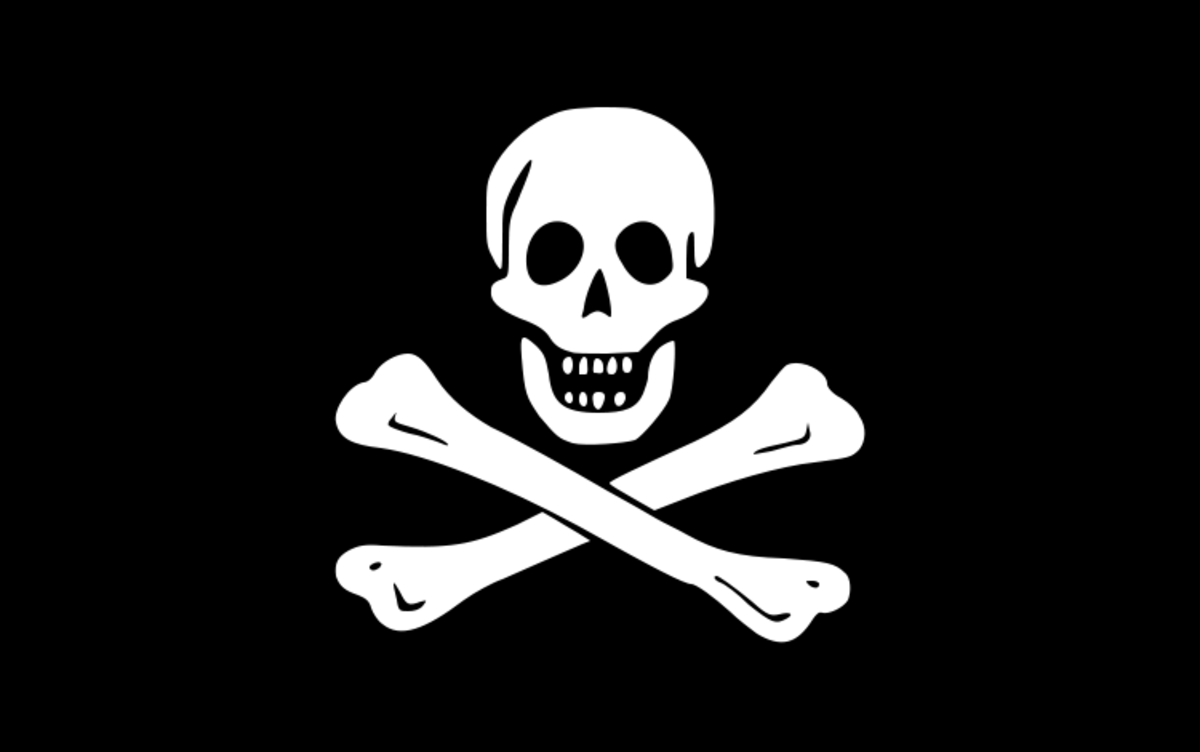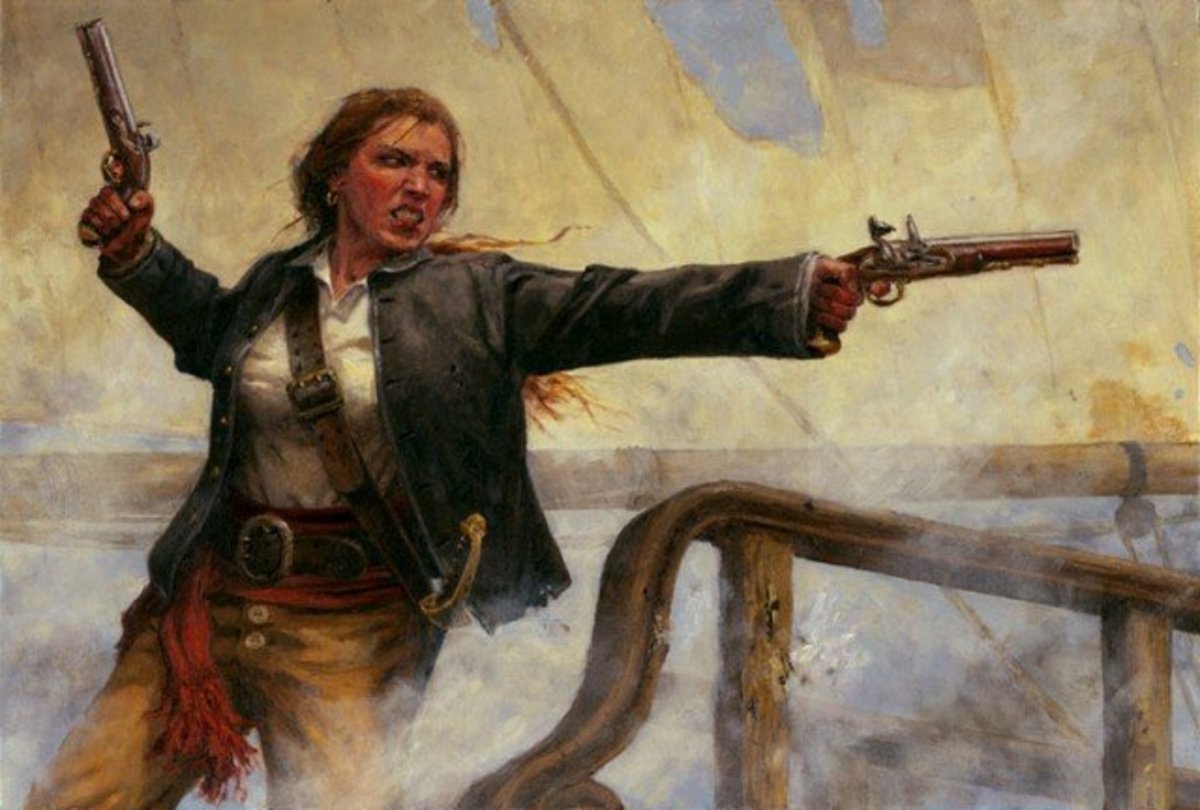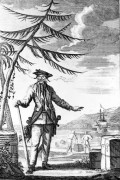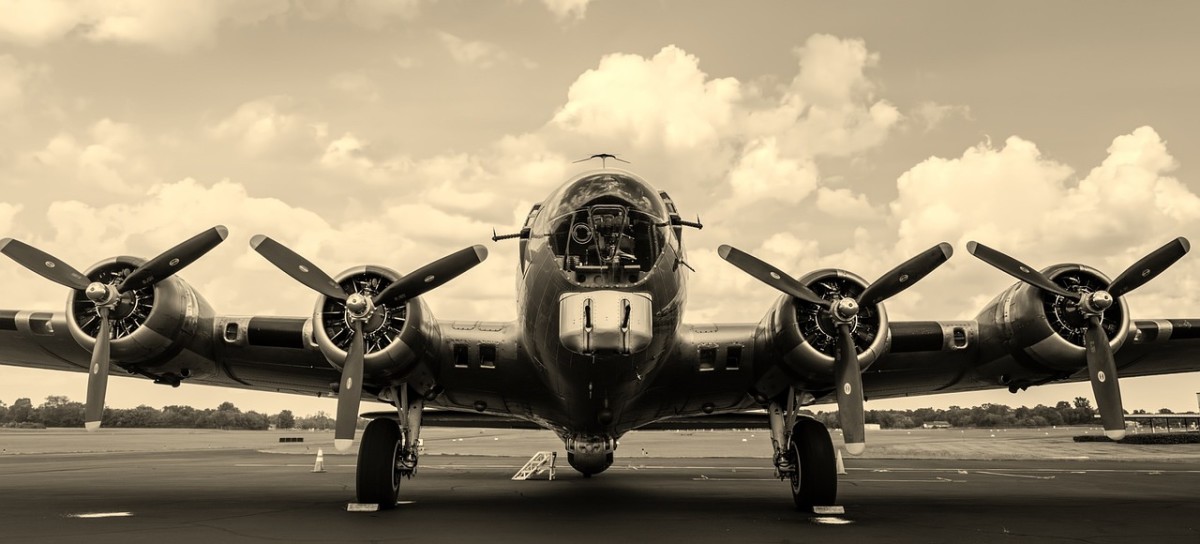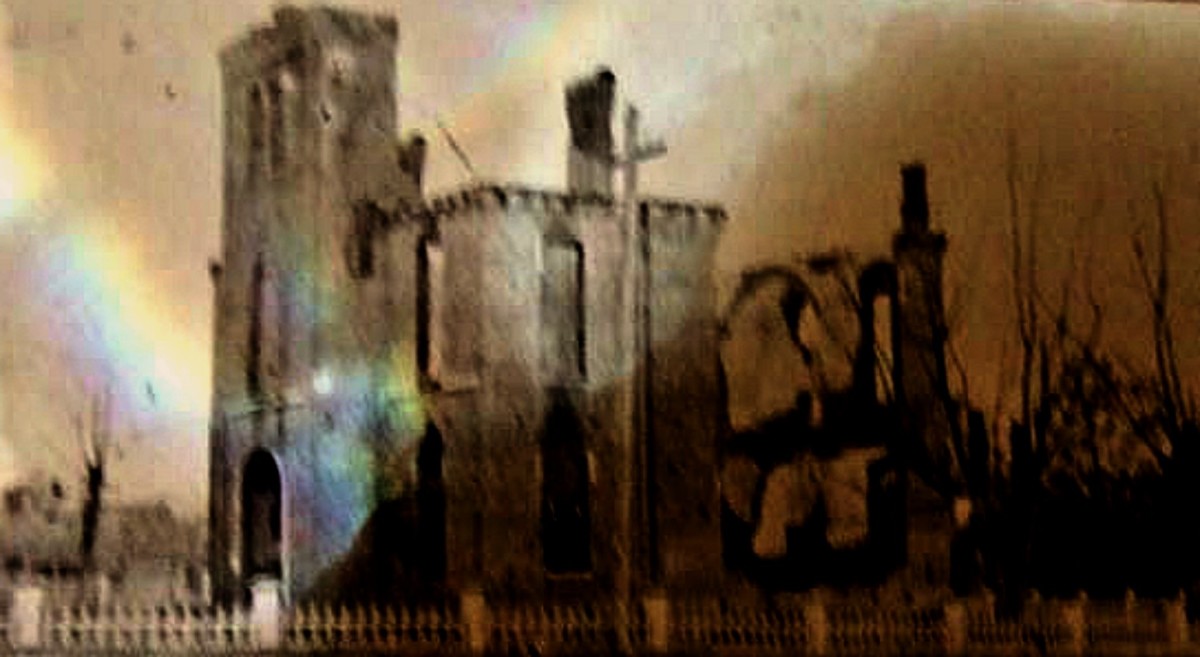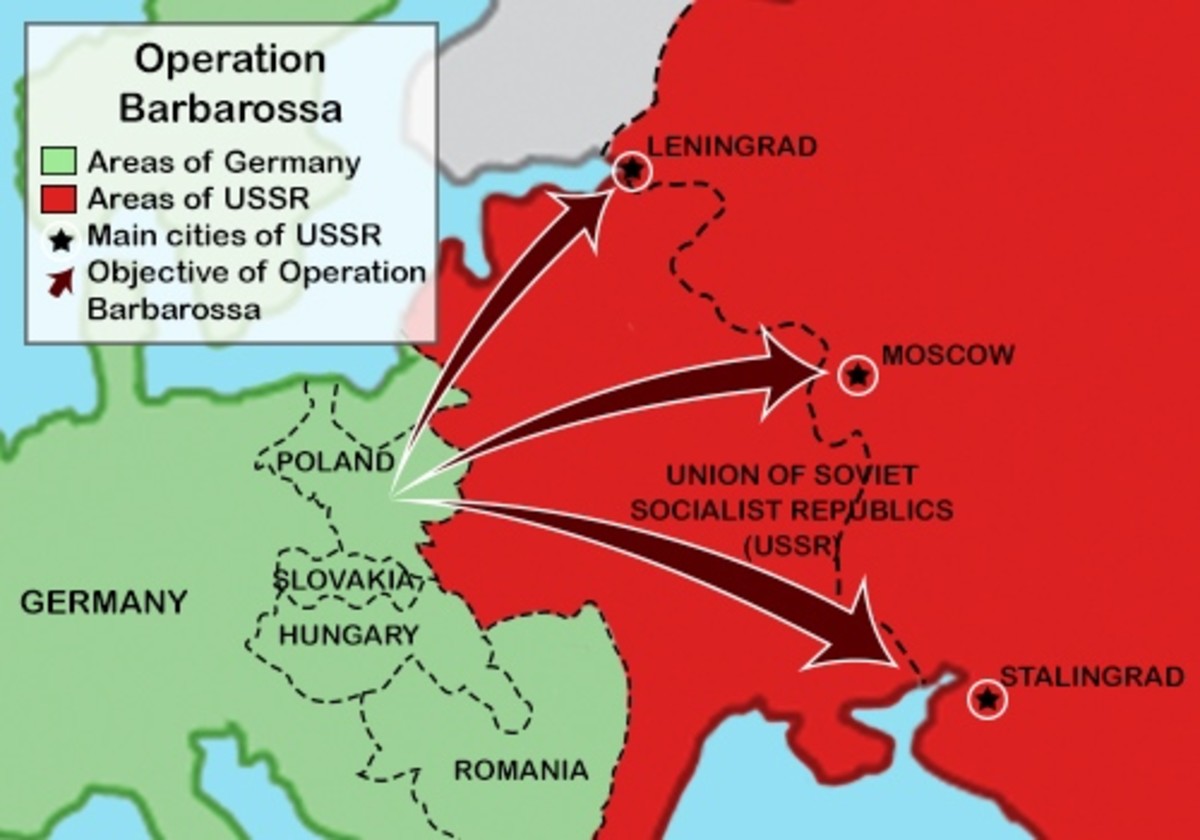The Golden Age of Piracy
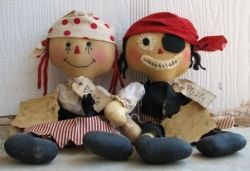
The Golden Age - 1700 to 1725
Bracing salt air. Eye patches and wooden legs. The lure of buried treasure. The Golden Age of Piracy has inspired books, movies, songs, and poetry. The early 1700s is filled with the exploits of pirates such as Edward "Blackbeard" Teach, "Black Sam" Bellamy, "Calico Jack" Rackham, Mary Read, and Anne Bonny.
Why did sailors risk facing the noose and turn to a life of piracy? Conditions on naval and merchant ships were notoriously deplorable. Sailors suffered from brutal discipline, poor diets, and unsanitary conditions. They were often poorly paid, or even cheated of their wages. Eating food infested with weevils and poorly preserved salt meats, piracy held much appeal.
Pirates weren't paid wages; plunder was shared generously among the crews. There was an abundance of food and drink, pirate captains were elected, and there was even compensation for those who were injured or crippled during pirate raids - on Bartholmew Roberts' crew they received a decade's wages. Runaway slaves found equality among the pirate crews - pirates of African descent made up a quarter of Blackbeard's crew - and even women took up piracy.
Soon dozens of pirate ships were operating around the worldâs oceans and seas. By the early 1700s, the English realized that piracy was a serious threat to their trade routes. Royal pardons were given to entice pirates away from piracy. Royal navy ships were sent out to protect the trade routes. Pirate hunters were commissioned to bring pirates to justice. Pirates that did not submit were hanged, their bodies displayed in iron cages as a warning to other pirates. The Golden Age had come to its end.
Interested in the Golden Age?
Check out these DVDs!

Piracy or Privateering
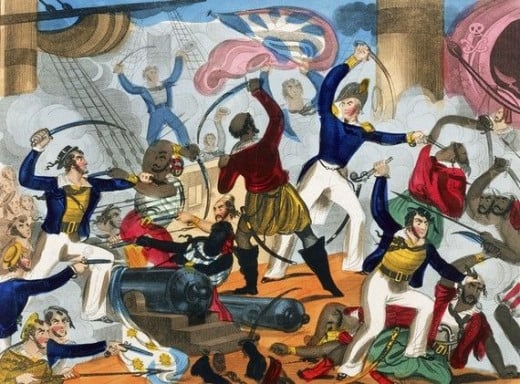
What was the difference between a pirate and a privateer? Essentially, a privateer had the backing of the government. A privateer was under commission to attack and capture merchant vessels that flew under the flag of enemy nations during times of war. Profits were to be shared with the investors, officers, and the crew. They could be given a letter of marque authorizing their activities at sea.
Why did privateering appeal to governments? Vessels and sailors could be mobilized on the high seas without committing their own naval officers or reaching into national treasuries. Backing came from private investors, who bore the cost of the voyages hoping to profit from any prizes gained from captured cargo. Enemy nations who depended on trade had to deploy their own ships away from battle to protect their merchant trade.
Some privateers crossed the line into piracy. When nations were not at war, there was no need for privateers, and many turned to piracy. Both pirates and privateers plundered captured ships, however piracy was considered an act of violence and was outlawed. One famous privateer turned pirate is Captain William Kidd.
"Life's pretty good, and why wouldn't it be? I'm a pirate, after all."
Johnny Depp
A Landlubber's Vote
Would you choose to be a pirate or a privateer?
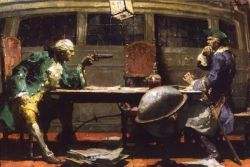
What was the King's Pardon?
The King's Pardon was extended to pirates who agreed to give up a life of piracy. Royal pardons were regularly issued by the monarch, usually when England was on the verge of war and privateers were needed. Pirates could then be used as reserve naval forces. As the Golden Age of Piracy came to its end, pardons were extended to pirates who vowed to give up their illegal activities. Those who feared the hangman's noose accepted a pardon. Edward "Blackbeard" Teach was a pirate who accepted the King's Pardon.
What is a Letter of Marque?
A "letter of marque and reprisal" was given to commissioned privateers. It bestowed on them the authority to attack and plunder enemy vessels during times of war. They could operate beyond international borders. The vessel was limited in its actions, drawing a line between piracy and privateering. The Royal Navy was not fond of privateers; they had more leeway than a naval ship. Merchant vessels could be pursued more directly, the discipline was more relaxed, there was less risk, and the pay was much better.
What is the Pirate's Code?
How do you prevent anarchy on a pirate ship? You develop a code of conduct. The stuff of legend and lore, the pirate code was actually the rules and regulations needed for survival at sea. It was written by the few pirates who had been educated, and was then explained to the rest of the crew, since most could not read or write. Why was it necessary? Living in such close quarters for long periods of time at sea required specific regulations. The Articles of Bartholomew Roberts from 1721 are the best known. They prohibited gambling, outlined the division of treasure, governed the settlement of arguments by sword or pistol - no fighting on ship of course - and included punishments such as slitting the nose and marooning. His articles form the infamous pirate code.
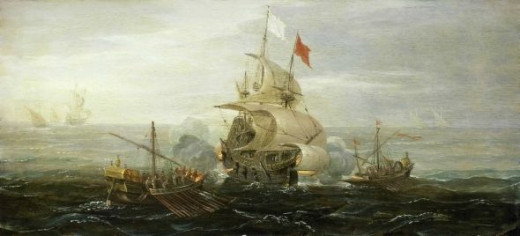
The Articles of Bartholomew Roberts - Below are some of the articles of the pirate's code.
- Every man shall have an equal vote in affairs of moment. He shall have an equal title to the fresh provisions or strong liquors at any time seized, and shall use them at pleasure unless a scarcity may make it necessary for the common good that a retrenchment may be voted.
- None shall game for money either with dice or cards.
- Each man shall keep his piece, cutlass and pistols at all times clean and ready for action.
- No boy or woman to be allowed amongst them. If any man shall be found seducing any of the latter sex and carrying her to sea in disguise he shall suffer death.
- None shall strike another on board the ship, but every man's quarrel shall be ended on shore by sword or pistol in this manner.
- No man shall talk of breaking up their way of living till each has a share of £l,000. Every man who shall become a cripple or lose a limb in the service shall have 800 pieces of eight from the common stock and for lesser hurts proportionately.
More About Black Bart
- Black Bart
More about Black Bart and his eleven articles.
"Mid pleasures and palaces though we may roam,
Be it ever so humble, there's no place like home."
John Howard Payne
Pirate Havens
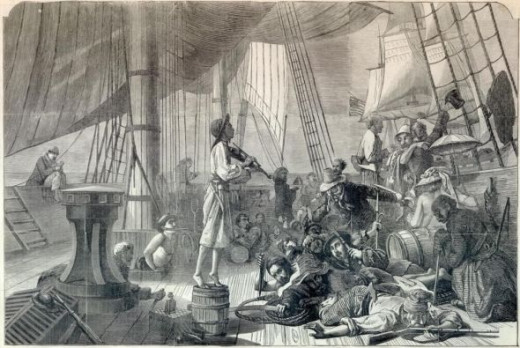
With the advent of piracy, pirates needed a place to hang out, and pirate havens began to crop up. Towns like Port Royal in Jamaica and Nassau in the Bahamas became known pirate havens. These places offered pirates safe harbors and merchants who would sell their ill-gotten loot. Below are some of the more infamous ones.
The Lure of Madgascar
250 miles off the coast of Africa, Madagascar offered access to sea routes traversed by merchant ships loaded with rich cargoes. It offered safe harbors, with no European country holding power over the island. Free of laws and the morality of religion, abundant in fresh water and supplies, by 1691 Madagascar gave birth to pirate “kingships,” small territories ruled by various pirate groups.
Legends of a fictitious place called Libertalia, set in Madagascar, abounded. Here was a pirate’s utopia, where there was no oppression, all were equals, and treasure and food was shared generously. Legendary pirates such as William Kidd, Robert Culliford, and Olivier Levasseur, frequented the island until piracy went into the decline.
What About Tortuga?
Located off modern Haiti, Tortuga was founded in the 1640s. Pirates migrated here along with criminals and runaway slaves. Ruled by the French for most of the 1660s, letters of marque were handed out to privateers authorizing the attack and capture of Spanish ships. Loot was to be shared with the Tortugan governors.
The Brethren of the Coast sprung up here, a coalition of privateers and pirates operating under a code of conduct. This code encompassed a swearing of allegiance to one another, the election of their captains and officers, and an equal share in their choice of missions. After war came to an end between France and Spain, letters of marque were withdrawn. Many pirates were hired out as pirate hunters by Royal services to suppress further acts of piracy.
Wicked Port Royal, Jamaica
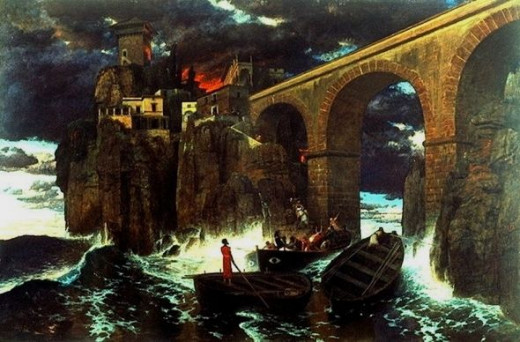
Port Royal was close to trade routes and offered a natural harbor that could accommodate large ships. Taken from the Spanish in 1655, the English did not have enough men to protect it, and so they offered safe harbor to pirates in return for her defense. By the 1660s, it had become known for its debauchery and earned the name "Sodom of the New World." In 1687, Jamaica passed anti-piracy laws, and Port Royal now became a place noted for the execution of pirates at Gallows Point. Pirates "Calico Jack" Rackham and Charles Vane were hanged here in 1720.
New Providence, A Pirate Republic
An island in the Bahamas, New Providence and its town of Nassau, was one of the last Caribbean pirate havens. The harbor offered two ways in and out, and was not deep enough to accommodate naval warships. It was close to American colonies and Cuba, offering a steady stream of ships to attack and plunder, as well as timber, fresh water and supplies. Pirate chieftains Thomas Barrow and Benjamin Hornigold declared New Providence a pirate republic and named themselves "governors." They were soon joined by the likes of pirates Charles Vane, Calico Jack Rackham, Blackbeard, Anne Bonny and Mary Read. When new governor Woodes Rogers arrived in September 1718, he clamped down on pirate activities based in Nassau. Those who did not accept pardons were hanged, and by 1721, the island had been cleared of its pirates.
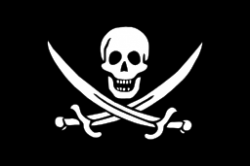
A History of the Jolly Roger
While the skull and crossed swords is the traditional pirate flag, the original flag wasn't even black - it was red and called the Joli Rouge (pretty red), which was anglicized into the Jolly Roger. It meant no quarter would be shown - no prisoners would be taken. "Calico Jack" Rackham flew the traditional pirate flag as we know it.
During the 17th and 18th centuries a plain black flag was more commonly flown. The pirate flag was taken from the skull and crossbones symbol set on a black field, which was a symbol of death used in medieval cemeteries. Pirates began adapting it with their own personal touches, the goal being to terrorize and intimidate victims into a quick and easy surrender. Below are some of the flags flown by famous pirates.
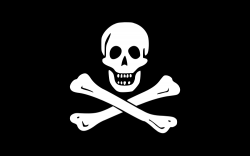
"Black Sam" Bellamy and Edward England
The traditional Jolly Roger.
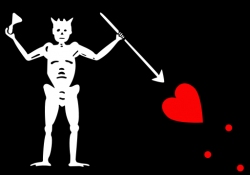
Edward "Blackbeard" Teach
A skeleton toasting the Devil while spearing a heart.
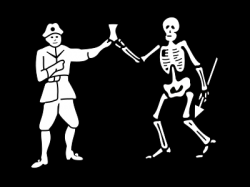
Bartholomew Roberts
Roberts and Death holding an hourglass, a symbol that your time was running out.
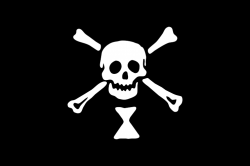
Emanuel Wynn
Skull and crossbones over an hourglass - symbols of death.
A General History of Pyrates
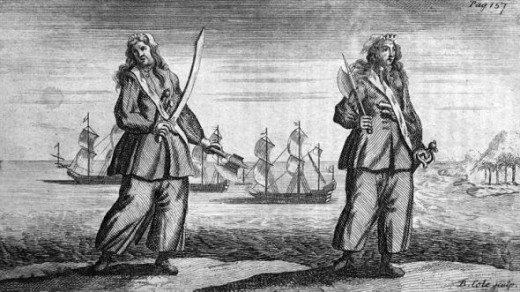
"A General Hisorie of the Robberies and Murders of the Most Notorious Pyrates" was published in 1724 in Britain. It contains the biographies of notorious pirates of its day and was penned by Captain Charles Johnson, although this is considered a pseudonym. Some believe the true author is Daniel Dafoe, author of Robinson Crusoe. It was written as a two volume book and is considered a primary source for facts related to the golden age of pirates and a must read for serious pirate fans only.
For True Pirate Lovers
Published in 1724, Captain Charles Johnson presents us with biographies of the pirates of his day.
The End of the Golden Age
The Golden Age came to its end, but piracy has yielded a wealth of legends and lore. Pirates no longer rule the seven seas, but they do rule our imagination. Check out these links to other pirate pages and enjoy matey!
- Ten Facts About Pirates
Learn about the myths of piracy. - A Pirate Slideshow
More about seven Golden Age pirates. - A Pirate Timeline
A timeline of pirates, ancient and modern and those in-between. - English to Pirate Translator
Hey thar bucko! Translate everyday conversation into pirate speak.



